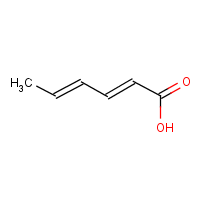Sorbic acid
Agent Name
Sorbic acid
CAS Number
110-44-1
Formula
C6-H8-O2
Major Category
Other Classes

Synonyms
(E,E)-2,4-Hexadienoic acid; (E,E)-Sorbic acid; Sorbic acid; 1,3-Pentadiene-1-carboxylic acid, (E,E)-; 2,4-Hexadienoic acid, (E,E)-; 2,4-Hexadienoic acid, (E,E)-; 2,4-Hexadienoic acid; 2-Propenylacrylic acid; 2E,4E-Hexadienoic acid; Acetic acid, (2-butenylidene)-; Acetic acid, crotylidene-; E 200; Hexadienoic acid; Kyselina 1,3-pentadien-1-karboxylova [Czech]; Kyselina sorbova [Czech]; Panosorb; Sorbistat; alpha-trans-gamma-trans-Sorbic acid; trans,trans-Sorbic acid; trans-trans-2,4-Hexadienoic acid; [ChemIDplus]
Category
Organic Acids
Description
Colorless or white solid; [HSDB] White crystalline solid; [MSDSonline]
Sources/Uses
Used as mold and yeast inhibitor, fungistatic agent, and preservative (foods, tobacco, cosmetics, pharmaceuticals, and silk-screen inks); Also used in drying oils, in alkyd type coatings, to improve milling characteristics of cold rubber, to inhibit fermentation in wines, to impregnate polyethylene wrappers for raw farm products, and to improve growth stimulation of animal feeds; [HSDB]
Comments
A skin, eye, and respiratory tract irritant; May cause skin sensitization; [ICSC] May cause skin and eye irritation; Emergency medical treatment: irritants; Sorbic acid 2.5% in petrolatum causes non-immunologic contact urticaria; [HSDB] Causes non-immunological contact urticaria; [Kanerva, p. 218] No adverse reproductive effects in long-term studies of mice and rats; [REPROTOX] A severe irritant; [RTECS] An uncommon cause of allergic contact dermatitis; Causes contact urticaria in 58% of subjects tested; [Marks, p. 151, 355] A severe irritant; High concentrations may cause corrosive injuries to the skin, eyes, mucous membranes, and upper respiratory tract; [CAMEO] An irritant; [MSDSonline]
Biomedical References
Exposure Assessment
Vapor Pressure
0.134 mm Hg
Explanatory Notes
VP from ChemIDplus;
Adverse Effects
Skin Sensitizer
Yes
Dermatotoxin
Skin burns
Diseases, Processes, and Activities Linked to This Agent
Diseases
Occupational diseases associated with exposure to this agent:
Processes
Industrial Processes with risk of exposure: